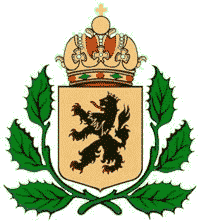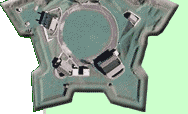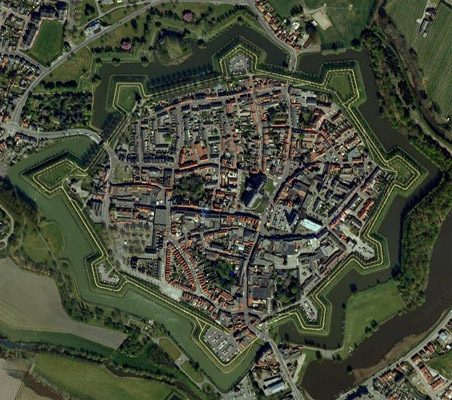Hulst is a fortified city near the border with Belgium. The region's liegelord granted Hulst city rights in 1180, which gave it the right to mint coinage, hold and benefit from markets, and, most interestingly to us, build city walls! Build walls the residents of Hulst may have immediately done, but the pretty walls we see today weren't constructed until the 17th century.
The Spanish Habsburgs took control of the Netherlands in the 15th century, and by all accounts governed its holdings badly. High taxes, slow response to requests for permission to do just about anything, and a general disdain for the people it ruled over are a pretty good recipe for revolt in any part of the world! As part of the Spanish Netherlands, Hulst was besieged at least four times, twice during the Eighty Years' War (1568-1648), or War of Dutch Independence.
The first siege resulted in the city being taken from the Spanish by the forces of Prince Maurits of the House of Orange, a royal family with claim to the crown of the Netherlands. The Spanish took Hulst back in 1596, but in 1645 Maurits' brother Frederick Henry (1584-1647) was back with 4500 Dutch troops. After only 28 days of fighting, Hulst was again Dutch/Orange/Netherlandsish. The siege of Hulst was to be the last major siege of the Eighty Years' War.
The starrish city wals of Hulst are said to have been built in the 17th century, so one assumes this took place after the second time the Dutch wrested the city from the Spanish. The walls proved a wise investment when the Spanish returned to Hulst in 1702 to try to get "their" city back, but spent so much time admiring the lovely walls that they were sent away, cityless.
Less successful was the city's defense against the French in 1747, during the War of Austrian Succession (1740-1748). During this period the House of Habsburg was being run from Austria, where in 1740 the death of Holy Roman Emperor Charles VI (1685-1740) created a succession crisis that was used by Prussia and France to challenge Habsburg power. With the French army approaching Hulst, Dutch commander Pieter de la Rocque ordered the razing of the nearby town of Sint Jansteen for the purpose of...well, nobody's sure what his intentions were, but the result was the French winning and occupying Hulst. The Treaty of Aix-la-Chapelle (1748) ended the war, with most everything returning to status quo ante bellum, or the same as 'twas before the war.
The southern Netherlands were annexed by France in 1794, to become part of the First French Republic. The region would be ruled by Napoleon (1769-1821)'s brother Louis Bonaparte (1778-1846) as the kingdom of Holland until 1810, when Napoleon forced his brother to abdicate, crowned Louis' 5-year-old son Napoleon Louis Bonaparte (1804-1831) as the new King of Holland, and then 10 days later just gave up on the whole thing and invaded, making all of the Netherlands and Holland part of the French empire. In the autumn of 1813, Napoleon, defeated at the Battle of Leipzig by a variety of allied nations, was forced to withdraw his troops from the Netherlands. William I of the Netherlands (1772-1843), one of those guys from the House of Orange, returned in 1813 from his Napoleon-inspired exile and became first Sovereign Prince of the Netherlands, and then King of the Netherlands in 1815.
|
As you can see above, Hulst is a lovely, living example of 17th century fortification, and remains unassailable, except for, y'know, by air. The word Hulst is Dutch for holly, which is present in the city's coat of arms. The suggestion has been made that the city's walls look like holly leaves and that's where the name came from, but if the walls were built in the 17th century, and the city gained its rights to be a city in the 12th century, that would mean either time travel or an amazing ability to predict the future in the city's founders. |
 |
 |











